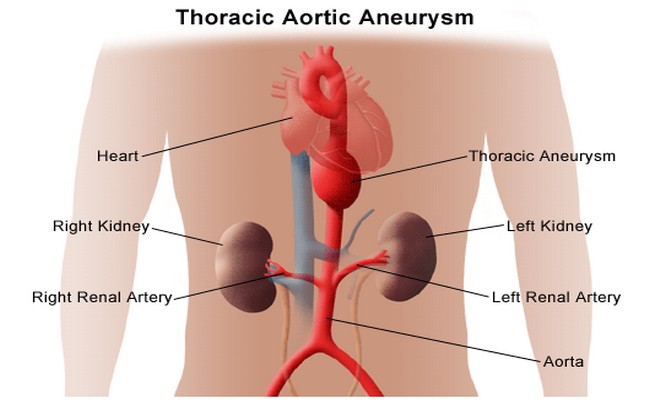Definition of Aortic Aneurysm Disease:
An aortic aneurysm disease is an enlargement or bulging in a section of the Aorta.
The Aortic is the largest artery in the human body. The aorta carries oxygen-rich blood away from the heart to all parts of the body.

Normally the walls of Arteries are thick and muscular that allows them to withstand a large amount of pressure. But sometimes a weak area develops in the wall of an artery that allows the pressure within the artery to push outwards, creating an enlargement or bulging area called an Aortic Aneurysm.
Types of Aortic Aneurysm Disease:
An aortic aneurysm can form in any section of the aorta. But they are most common in two types, which are discussed below:
1. Abdominal Aortic Aneurysm:
An aneurysm occurs in the section of the Aorta that runs through the Abdomen.
2. Thoracic Aortic Aneurysm:
An aneurysm occurs in the aorta that passes through the chest cavity.
Causes of Aortic Aneurysm Disease:
There are different causes for aortic aneurysm; those are mentioned in the following:
- Atherosclerosis,
- High blood pressure,
- Local injury to the artery,
- Age,
- Congenital Abnormally,
- Diabetes,
- Sexually transmitted disease (STD) syphilis,
- Rheumatoid Arthritis,
- Psoriasis,
- Male sex,
- Smoking,
- Genetic.
Sign and Symptoms of Aortic Aneurysm Disease:
Various sign and symptoms of aortic aneurysm disease, those are mentioned in the below:
- Pain in the jaw, neck, upper back or chest,
- Pain in the lowers back, Abdomen, or groin,
- Coughing,
- Hoarseness or difficulty breathing,
- A pulsating sensation in the abdomen,
- In abdominal aneurysm appears cold foot or a black or blue toe,
- Difficulty or pain while swallowing (pressure on the esophagus),
- Rupture of an aneurysm can cause loss of consciousness, stroke, shock, or a heart attack,
- Low blood pressure,
- Dysphagia,
- Cyanosis,
- Distended neck veins,
- Anxiety and fatigue.
Diagnosis and Test for Aortic Aneurysm Disease:
There are different diagnosis and test systems for aortic aneurysm disease; which are in the following:
- Medical history and physical exam
- ECG,
- Echocardiography,
- USG of the chest and abdomen,
- X-Ray,
- CT Angiogram
- MRI of Chest and Abdomen,
- Genetic Testing.
Treatment for Aortic Aneurysm Disease:
Treatment depends on its size, location, and overall health.
- Watchful waiting,
- Control of blood pressure (Beta Blockers),
- Angiotensin II receptor blockers( prescribed when beta-blockers cannot control blood pressure),
- Statins (Help to lower cholesterol, which can help reduce blockages in arteries and reduce the risk of aneurysm complications. Examples of statins include atorvastatin (Lipitor), lovastatin (Altoprev), simvastatin (Zocor), and others),
- Surgery (open or endovascular aneurysm repair).
A complication of Aortic Aneurysm Disease:
Various complications of aortic aneurysm disease are mentioned below:
- Fatal hemorrhage,
- Shock,
- Myocardial ischemia,
- Stroke,
- Paraplegia due to interruption of the anterior spinal artery,
- Abdominal ischemia.
Nursing Intervention for Aortic Aneurysm Disease:
Various nursing intervention for aortic aneurysm disease is in the following:
- Prepare the client for serial ultrasonography, which is conducted every 6 months to assess the size of the aneurysm.
- Encourage patient to avoid strain during defecation and give glycerin suppository or enema if constipation present.
- Instruct patient to avoid heavy lifting.
- Continuous cardiac monitoring and assessment for tachycardia and other irregular rhythms.
- Continuous monitoring blood pressure with an arterial line; desired systolic pressure is 100 to 120 mmHg.
- Maintain target MAP at 65 to 75 mm Hg and heart rate between 50 and 60b/m.
- Carefully monitor CVP (central venous pressure )/PA (pulmonary artery) pressure.
- If surgical intervention is needed, provide psychological support, and prepare for surgery.
- For post-surgical patients, discuss warning signs of postoperative complications such as fever, inflammation in the surgical site, bleeding, and swelling.
- Check chest tube drainage and drains; note drainage on dressings, and mark the boundaries.
- Administer pain medication as ordered.
- For the first 2 or 3 days postoperatively, keep the head of the bed lower than 45 degrees and elevate the patient’s legs 20 to 30 degrees, to avoid pressure on incision sites.
- Evaluate for signs and symptoms of hypovolemia.
- Monitor hourly fluid intake and urine output.
- Frequently check the complete blood count for signs of bleeding and blood urea nitrogen and creatinine levels for signs of renal insufficiency.
- Daily check of weight.
- Closely monitor and notify a physician about persistent cough, vomiting, or systolic blood pressure above 180mmhg because of the increased risk for hemorrhage.
- Continue I.V antihypertensive medication if persistent blood pressure high.
- After surgery, instruct the client to modify his lifestyle as if he had been diagnosed with hypertension because atherosclerosis is the primary cause of aneurysm.
- Encourage the patient to express concerns.
- The patient was instructed to gradually increase activities.
- Educate on signs and symptoms of complications.
More questions related to this topic:
- Aortic Aneurysm: Causes, Symptoms, Treatments.
- Aortic Aneurysm: Abdominal and Thoracic.
- Aortic Aneurysm: Facts on Symptoms, Surgery, and Repair.
- Abdominal Aortic Aneurysm: Overview.
- What is an aneurysm of the Aorta?
- What is an Aneurysm of the Heart?
- Where is the Aorta?
- Aortic Aneurysm Symptoms.
- Aortic Aneurysm Treatment.

Maria Khatun Mona is a Founder and Editor of Nursing Exercise Blog. She is a Nursing and Midwifery Expert. Currently she is working as a “Senior Staff Nurse” at “Dinajpur Medical College Hospital”, Bangladesh. She has great passion in writing different articles on Nursing and Midwifery. Mail her at “maria.mona023@gmail.com”

Way cool! Some very valid points! I appreciate you writing this post plus the rest of the website is really good.